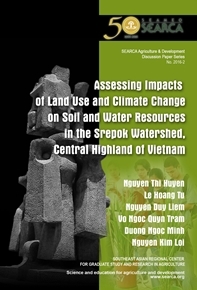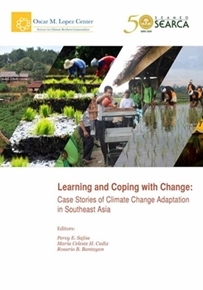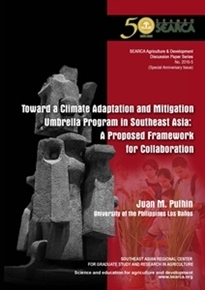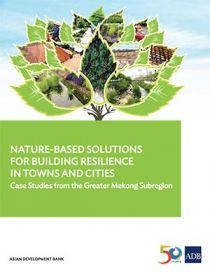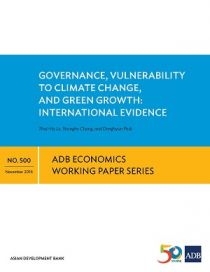Publications
This contains experience notes, adaptation notes, policy briefs, policy papers, technical reports, stories on good practices, and other publications related to climate change adaptation and mitigation in Southeast Asia not just from SEARCA, but also from KC3's partners and other agencies/institutions.
The Srepok River basin, which flows along four provinces in Vietnam and parts of Cambodia, is presently facing critical issues such as floods and droughts, pollution of waterways, deforestation of catchments, erosion and resultant sedimentation of reservoirs, overexploitation of groundwater, water-use conflicts, and transborder issues. This study aims to investigate changes in streamflow and sediment yield that result from land use changes, and climatic variation in the Srepok watershed. Plausible scenarios of land use change are simulated through Geographic Information…
Climate change is one of the defining issues of our time. Over 30 UNESCO programmes in the sciences, education, culture, and communication contribute to creating knowledge, educating and communicating about climate change, and to understanding the ethical implications for present and future generations. The UNESCO Climate Change Initiative, launched by the Director-General in Copenhagen, federates UNESCO’s work and joins it with that of other UN bodies and aims to help Member States to mitigate and adapt to climate change, to educate…
Rural communities throughout the Asia-Pacific are generally more exposed to climate-driven changes to their livelihoods than those in larger/urban communities. A team led by Dr. Chris Jacobson, Sustainability Research Centre, University of the Sunshine Coast, Australia, developed and piloted a community resilience tool to be used to support climate change adaptation within existing development planning pathways. The framework included 39 key questions based around the outcomes related to livelihoods and environment, infrastructure, community, and climate change and disaster management. The…
Klima 101: A Climate Change Guidebook for Philippine Journalists aims to help journalists and editors, including journalism teachers and trainers, to navigate and understand scientific issues better. It hopes to provide a clear idea of the nature of climate change, what types of data and information journalists need to write or produce a story (particularly on the impact of climate change on agriculture and food security), how to report climate issues effectively, and how to influence decision-making in the process, as…
The Southeast Asian Regional Center for Graduate Study and Research in Agriculture (SEARCA) is proud to present this pioneering work, featuring selected case stories on climate change adaptation initiatives that are being implemented in Southeast Asia. This book Learning and Coping with Change: Case Stories of Climate Change Adaptation in Southeast Asia is the outcome of the First Regional Knowledge Sharing Writeshop on Climate Change Adaptation (CCA) in Inclusive and Sustainable Agricultural and Rural Development (ISARD) held on 15–17 April…
Southeast Asia is highly vulnerable to climate change since a large proportion of its population is concentrated along its coastlines with livelihoods that rely on agriculture and natural resources, including fisheries and forestry. The region is annually affected by climate extremes, particularly floods, droughts, and tropical cyclones, threatening the livelihood of poor people living in rural areas who have limited adaptive capacity (IFAD 2009). Climate change in Southeast Asia is expected to lead to significant variations in precipitation patterns, increased…
This study sought to determine microscale damage estimates of the largest flood event in the history of the municipality of Jabonga in the province of Agusan del Norte. Jabonga is a lakeside municipality adjacent to Lake Mainit, the fourth largest lake in the Philippines. The study sought to determine flood-prone areas in the municipality, characterize the flood event that occurred in the site from December 2010 to March 2011, estimate actual and potential damage for different flood scenarios, and determine…
Green infrastructure can play a significant role in offsetting losses from climate-related disasters and contribute to building resilience through rehabilitation and expansion of natural ecosystems within built areas. Urban populations are projected to increase from 54% to 66% of the global population by 2050, with close to 90% of the increase concentrated in Asia and Africa. Cities and towns—a growing source of greenhouse gas emissions—will need to address challenges posed by climate change. A nature-based approach in identifying climate change…
Guidelines for policy makers and proposal developers provide pragmatic advice in designing gender-responsive climate policies and funding proposals. Actively engaging women in climate mitigation activities can yield multiple benefits, including improved jobs, better livelihoods, and more equitable revenue flows. Efforts are moving forward to design climate funding mechanisms to help capture these benefits, but policymakers and other stakeholders need more guidance on designing gender-responsive climate policies and funding proposals. The guidelines in this publication fill this void. It is hoped…
Examining the role of governance and vulnerability to climate change in green growth using a global panel data set, findings suggest promoting good governance and reducing climate change vulnerability can contribute to a cleaner environment. We find that governance has a positive effect on environmental performance and vulnerability to climate change has a negative effect. Promoting good governance and reducing climate change vulnerability can thus contribute to a cleaner environment. We find qualitatively similar results for the subsample of high-income…

